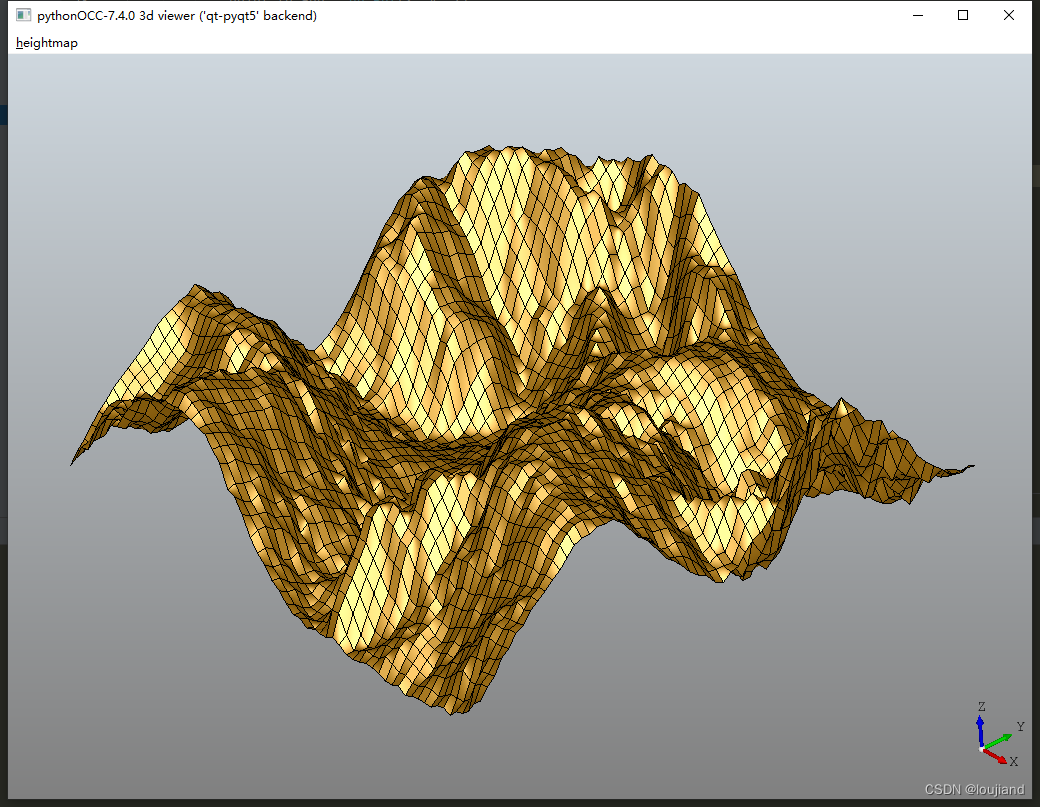源代码:
##Copyright 2017 Thomas Paviot (tpaviot@gmail.com)
##
##This file is part of pythonOCC.
##
##pythonOCC is free software: you can redistribute it and/or modify
##it under the terms of the GNU Lesser General Public License as published by
##the Free Software Foundation, either version 3 of the License, or
##(at your option) any later version.
##
##pythonOCC is distributed in the hope that it will be useful,
##but WITHOUT ANY WARRANTY; without even the implied warranty of
##MERCHANTABILITY or FITNESS FOR A PARTICULAR PURPOSE. See the
##GNU Lesser General Public License for more details.
##
##You should have received a copy of the GNU Lesser General Public License
##along with pythonOCC. If not, see <http://www.gnu.org/licenses/>.
from __future__ import division, print_function
import math
from OCC.Core.gp import gp_Pnt
from OCC.Core.BRepBuilderAPI import (BRepBuilderAPI_MakeEdge,
BRepBuilderAPI_MakeFace,
BRepBuilderAPI_MakeWire)
from OCC.Core.TColgp import TColgp_Array2OfPnt
from OCC.Core.GeomAPI import GeomAPI_PointsToBSplineSurface
from OCC.Core.GeomFill import GeomFill_SimpleBound, GeomFill_ConstrainedFilling
from OCC.Core.GeomAbs import GeomAbs_C2
from OCC.Display.SimpleGui import init_display
from OCC.Core.BRepAdaptor import BRepAdaptor_CompCurve, BRepAdaptor_HCompCurve
try:
from PIL import Image
HAVE_PIL = True
except ImportError:
print("PIL not found. Heightmap from image not available.")
HAVE_PIL = False
def x2_y2(event=None):
def f(x, y):
""" Returns z = f(x,y)
"""
z = x*x - y*y
return z
heightmap_from_equation(f)
def cosxsinxcosysiny(event=None):
def f(x, y):
z = 5 * math.cos(x) * math.sin(x) * math.sin(y) * math.cos(y)
return z
heightmap_from_equation(f, 0, math.pi, 0, math.pi)
def heightmap_from_equation(f, x_min=-1, x_max=1, y_min=-1, y_max=1):
""" takes an equation z= f(x,y)
and plot the related point cloud as a bspline surface
"""
print("compute surface")
n = 100
# initialize x axis
step_x = (x_max - x_min) / n
x_ = []
for i in range(n):
x_.append(x_min + i* step_x)
# initialize y axis
step_y = (y_max - y_min) / n
y_ = []
for i in range(n):
y_.append(y_min + i* step_y)
# compute z
array = TColgp_Array2OfPnt(1, len(x_), 1, len(y_))
i = 1
for x in x_:
j = 1
for y in y_:
z = f(x, y)
point_to_add = gp_Pnt(x, y, z)
array.SetValue(i, j, point_to_add)
j += 1
i += 1
print("bspline surface creation")
bspl_surface = GeomAPI_PointsToBSplineSurface(array, 3, 8, GeomAbs_C2, 0.001).Surface()
display.DisplayShape(bspl_surface, update=True)
def boundary_curve_from_2_points(p1, p2):
# first create an edge
e0 = BRepBuilderAPI_MakeEdge(p1, p2).Edge()
w0 = BRepBuilderAPI_MakeWire(e0).Wire()
# boundary for filling
adap = BRepAdaptor_CompCurve(w0)
p0_h = BRepAdaptor_HCompCurve(adap)
boundary = GeomFill_SimpleBound(p0_h, 1e-6, 1e-6)
return boundary
def heightmap_from_image(event=None):
""" takes the heightmap from a jpeg file
and apply a texture
this example requires numpy/matplotlib
"""
print("opening image")
heightmap = Image.open('../assets/images/mountain_heightmap.jpg')
heightmap.show()
width = heightmap.size[0]
height = heightmap.size[1]
# create the gp_Pnt array
print("parse image and fill in point array")
for i in range(1, width):
for j in range(1, height):
# all 3 RGB values are equal, just take the first one
# vertex 1
height_value = heightmap.getpixel((i-1, j-1))[0]
v1 = gp_Pnt(i, j, float(height_value)/10)
# vertex 2
height_value = heightmap.getpixel((i, j-1))[0]
v2 = gp_Pnt(i+1, j, float(height_value)/10)
# vertex 3
height_value = heightmap.getpixel((i, j))[0]
v3 = gp_Pnt(i+1, j+1, float(height_value)/10)
# vertex 4
height_value = heightmap.getpixel((i-1, j))[0]
v4 = gp_Pnt(i, j+1, float(height_value)/10)
# boundaries
b1 = boundary_curve_from_2_points(v1, v2)
b2 = boundary_curve_from_2_points(v2, v3)
b3 = boundary_curve_from_2_points(v3, v4)
b4 = boundary_curve_from_2_points(v4, v1)
#
bConstrainedFilling = GeomFill_ConstrainedFilling(8, 2)
bConstrainedFilling.Init(b1, b2, b3, b4, False)
srf1 = bConstrainedFilling.Surface()
# make a face from this srf
patch = BRepBuilderAPI_MakeFace()
bounds = True
toldegen = 1e-6
patch.Init(srf1, bounds, toldegen)
patch.Build()
display.DisplayShape(patch.Face())
# then create faces
print("%s%%" % int(float(i) / width * 100))
#display.process_events()
display.FitAll()
# finally display image
heightmap.show()
if __name__ == "__main__":
display, start_display, add_menu, add_function_to_menu = init_display()
add_menu('heightmap')
add_function_to_menu('heightmap', x2_y2)
add_function_to_menu('heightmap', cosxsinxcosysiny)
if HAVE_PIL:
add_function_to_menu('heightmap', heightmap_from_image)
start_display()
运行效果:生成基于拓扑结构的高度图
























 9820
9820











 被折叠的 条评论
为什么被折叠?
被折叠的 条评论
为什么被折叠?










